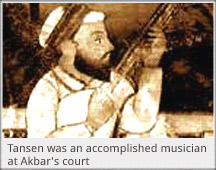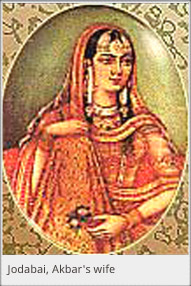Humayun’s heir, Akbar, was born in exile and was only 13 years old when his father died. Thanks to his exceptionally capable guardian, Bahram Khan, he survived to demonstrate his worth. Akbar’s reign holds a certain prominence in history; he was the ruler who actually fortified the foundations of the Mughal Empire. After a series of conquests he managed to subdue most of India.
 Areas not under the empire were designated as tributaries. He also adopted a conciliatory policy towards the Rajputs, hence reducing any threat from them. Akbar was not only a great conqueror, but a capable organizer and a great administrator as well. He set up a host of institutions that proved to be the foundation of an administrative system that operated even in British India.
Areas not under the empire were designated as tributaries. He also adopted a conciliatory policy towards the Rajputs, hence reducing any threat from them. Akbar was not only a great conqueror, but a capable organizer and a great administrator as well. He set up a host of institutions that proved to be the foundation of an administrative system that operated even in British India.
 Akbar’s rule also stands out due to his liberal policies towards the non-Muslims, his religious innovations, the land revenue system and his famous Mansabdari system. Akbar’s Mansabdari system became the basis of Mughal military organization and civil administration.
Akbar’s rule also stands out due to his liberal policies towards the non-Muslims, his religious innovations, the land revenue system and his famous Mansabdari system. Akbar’s Mansabdari system became the basis of Mughal military organization and civil administration.
 The reign of Akbar was a period of renaissance of Persian literature. The Ain-i-Akbari gives the names of 59 great Persian poets of Akbar’s court. History was the most important branch of Persian prose literature. Abul Fazl’s Akbarnama and Ain-i-Akbari were complementary works. Akbar and his successors, Jehangir and Shah Jehan greatly contributed to the development of Indian music. Tansen was the most accomplished musician of the age. Ain-i-Akbari gives the names of 36 first-rate musicians of Akbar’s court where Hindu and Muslim style of music mingled freely.
The reign of Akbar was a period of renaissance of Persian literature. The Ain-i-Akbari gives the names of 59 great Persian poets of Akbar’s court. History was the most important branch of Persian prose literature. Abul Fazl’s Akbarnama and Ain-i-Akbari were complementary works. Akbar and his successors, Jehangir and Shah Jehan greatly contributed to the development of Indian music. Tansen was the most accomplished musician of the age. Ain-i-Akbari gives the names of 36 first-rate musicians of Akbar’s court where Hindu and Muslim style of music mingled freely.
 The Mughal architectural style began as a definite movement under his rule. Akbar’s most ambitious and magnificent architectural undertaking was the new capital city that he built on the ridge at Sikri near Agra. The city was named as Fatehpur to commemorate Akbar’s conquest of Gujrat in 1572. The most impressive creation of this new capital is the grand Jamia Masjid. The southern entrance to the Jamia Masjid is an impressive gateway known as Buland Darwaza.
The Mughal architectural style began as a definite movement under his rule. Akbar’s most ambitious and magnificent architectural undertaking was the new capital city that he built on the ridge at Sikri near Agra. The city was named as Fatehpur to commemorate Akbar’s conquest of Gujrat in 1572. The most impressive creation of this new capital is the grand Jamia Masjid. The southern entrance to the Jamia Masjid is an impressive gateway known as Buland Darwaza.
Like most other buildings at Fatehpur Sikri, the fabric of this impressive gateway is of red sandstone that is decorated by carvings and discreet inlaying of white marble. Of all the Mughals, Akbar’s reign was the most peaceful and powerful. With his death in 1605, ended a glorious epoch in Indian history.

This article was last updated on Sunday, June 01, 2003








